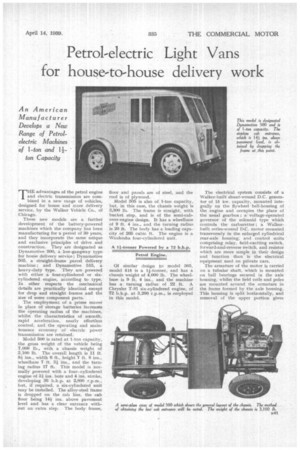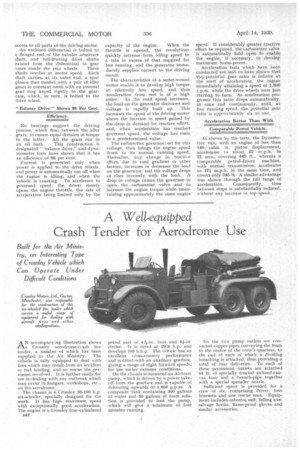Petrol-electric Light Vans for house-to-house delivery work
Page 51

Page 52

If you've noticed an error in this article please click here to report it so we can fix it.
An American M arzu facturer Develops a New Range of Petrolelectric Machines of 1-ton and ton Capacity
THE advantages of the petrol engine and electric transmission are combined in a new range of vehicles, designed for house and store delivery service, by the Walker Vehicle Co., of Chicago.
These new models are a further development of the battery-powered machines which the company has been manufacturing for a period of 30 years, and they incorporate the same unique and exclusive principles of drive and construction. They are designated as Dynamotive 500, a low-gangway type for house delivery service; Dynamotive 505, a straight-frame parcel delivery machine; and Dynamotive 515, a heavy-duty type. They are powered with either a four-cylindered or sixcylindered engine, according to type. In other respects the mechanical details are practically identical except for drop and straight frames and the size of some component parts.
The employment of a prime mover in place of storage batteries increases the operating radius of the machines, whilst the characteristics of smooth, rapid acceleration, nearly effortless control, and the .operating and maintenance economy of electric power transmission are retained.
Model 500 is rated at 1-ton capacity, the gross weight of the vehicle being 7,000 lb., with a chassis weight of 3,100 lb. The overall length is 11 ft. 81 ins., width 6 ft., height 7 ft. 8 ins., wheelbase 7 ft. 3t ins„ and the turning radius 17 ft. This model is normally powered with a four--cylindereci engine of 3i ins, bore and 4 ins, stroke, developing 36 b.h.p. at 2,800 r.p.m., but, if required, a six-cylindered unit may be installed. The alloy-steel frame is dropped on the cab line, the cab floor being 14-t ins, above pavement level and has a clear entrance without an extra step. The body frame, floor and panels are of steel, and the roof is of plywood.
Model 505 is also of 1-ton capacity, but, in this case, the chassis weight is 3,300 lb. The frame is straight, with bucket step, and is of the semi-cabover-engine design. It has a wheelbase of 9 ft. 4 ins., and the turning radius is 20 ft. The body has a loading capacity of 265 cubic ft. The engine is a Waukesha four-cylindered unit.
Of similar design to model 505, model 515 is a 11-tonner, and has a chassis weight of 4,000 lb. The wheelbase is 9 ft. 4 ins., and the machine has a turning radius of 22 ft. A Chrysler T-81 six-cylindered engine, of 72 b.h.p. at 3,200 r.p.m., is employed in this model. The electrical system consists of a Walker-built shunt-wound D.C. generator of 15 kw. capacity, mounted integrally on the flywheel hell-housing of the. engine and occupies the place of the usual gearbox ; a voltage-operated governor of the solenoid type which controls the carburetter ; a Walkerbuilt series-wound D.C. motor mounted transversely in the enlarged cylindrical rear-axle housing; and control units comprising relay, field-exciting switch, forward-and-reverse switch, and resistor which are more simple in their design and function than is the electrical equipment used on private cars.
The armature of the motor is carried on a tubular shaft, which is mounted en ball bearings secured in the axle housing, whilst the field coils and poles are mounted around the armature in the frame formed by the axle housing. This housing is split horizontally, and removal of the upper portion gives access to all parts of the driving motor.
An enclosed differential is bolted to a flanged end of the tubular armature shaft, and full-floating drive shafts extend from the differential to gear cases inside the rear wheels. These shafts revolve at motor speed. Each shaft carries, at its outer end, a spur pinion that meshes with a pair of idler gears in constant mesh with an internal gear ring keyed rigidly to the gearcase, which, in turn, is bolted to the drive wheel.
No bearings support the driving pinions, which float between the idler gears, to ensure equal division of torque to the latter. All the gears run in an oil bath. This construction is designated " balance drive," and dynamometer tests have shown that it has an efficiency of 98 per cent.
Current is generated only when power is applied to the drive wheels, and power is automatically cut off when the engine is idling, and when the vehicle is coasting. To accelerate to governed speed, the driver merely opens the engine throttle, the rate of accejeration being limited only by the capacity of the engine. When the throttle is opened, the revolutions quickly increase from idling speed to a rate in excess of that required for free running, and the generator immediately supplies current to the driving motor.
The characteristics of a series-wound motor enable it to develop high torque at relatively low speed, and thus acceleration from rest is of a high order. As the road speed increases, the load on the generator decreases and voltage is rapidly built up. This increases the speed of the driving motor above the increase in speed gained by the drop in demand for tractive effort, and, when acceleration has reached governed speed, the voltage has risen to a predetermined value.
The carburetter governor; set for this voltage, then brings the engine speed down to its normal running speed. Thereafter, any change in tractive• effort, due to road gradient or other factors, increases or decreases the load on the generator, and the voltage drops or rises inversely with the load. A drop in voltage causes the governor to open the. carburetter valve and to increase the engine torque while maintaining approximately the same engine
speed. If considerably greater tractive effort be required, the carburetter valve is automatically held open to enable the engine, if necessary, to develop maximum horse-power.
Acceleration tests which have been conducted are said to have shown that the, potential gear ratio is infinite at the start of acceleration, the engine immediately attaining a speed of 1,800 r.p.m. while the drive wheels were just starting to turn. As acceleration progresses this ratio drops automatically, at once and continuously, until, at free running speed, the potential gear ratio is approximately six to one.
As shown by the tests, the Dynamotive van, with an engine of less than 140, cubic in. piston displacement, accelerates to about 22 m.p.h. in 21 secs., covering 445 ft., whereas a comparable petrol-driven machine, with normal transmission, accelerates to 171 m.p.h. in the same time, and covers only 345 ft. A similar advantage was shown through the full range of acceleration. Consequently, time between stops is substantially reduced, without any increase in top speed.




















































































